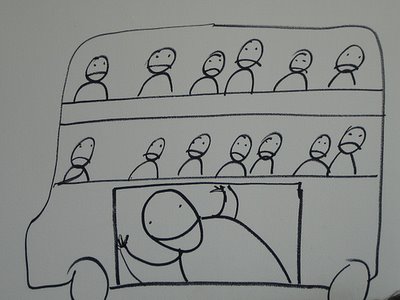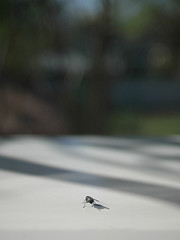
I took the 242 bus to Shoreditch to see ‘Some pictures and a song’ – Claire Harvey’s installation at
Store.
I was tempted up Hoxton Street having read that the installation includes drawings of people on scotch tape, stuck onto the walls. I imagined the walls plastered with hundreds of these figures, like the end of a brainstorming workshop gone mad.
It is more restrained than I'd anticipated: the sticky tape people are confined to a small area of one wall, over in the corner, by the front window of the gallery. Each
drawing is made on two pieces of sticky tape: one for the person, one for their shadow.
They are a loose collection of people, walking away from me; detached from me; detached from each other; detached from the ground on which their shadow would have been cast; and as the title of the piece acknowledges, easily detached from the wall.
On the other side of the window I was aware of the occassional passer by walking down Hoxton Street to the college next door and the little shops.
The installation really came to life when I took up the invitation on the record player to play the 7inch single that sat on the turntable.
I heard Harvey sing a wistful song about a fly who fell victim to her botched attempt to save it after it had flown into her studio and got stuck on some oil paint on one of her paintings that had not yet dried.
As I listened I looked around the gallery: bare wooden floor, some oil paintings on the wall, Hoxton outside.
The paintings on the wall are neither large nor bright. The colours used are greyish blue and white. Some of the paintings show people on the edge of the land and the sea, alone but not lonely, absorbed in what they are doing.
One shows a close up painting of a person’s face, smelling a cheese, what is he thinking as he inhales? The next painting pans back, and shows all of the cheese smeller, it’s a young man. The title of the picture (cheese counter) betrays the fact that he is in a supermarket, but the hazy blue/white/ grey way the cheese counter is painted makes it looks as though he too could be on the edge of land and sea.
The installation took me right back to student days . Maybe because the room was bare, or because it was a record not a CD player, or because no-one in the installation was in a rush, or wearing a suit (unless you count me standing there with my rucksack on my back), or doing anything particularly demanding.
The lady at the gallery said to me ‘its like slipping back into a familiar memory of something that never actually happened to you, just like the fly story may never have happened’.
(The exhibition is running until 1 July 06: read Russell Herron's account of the
private view)



